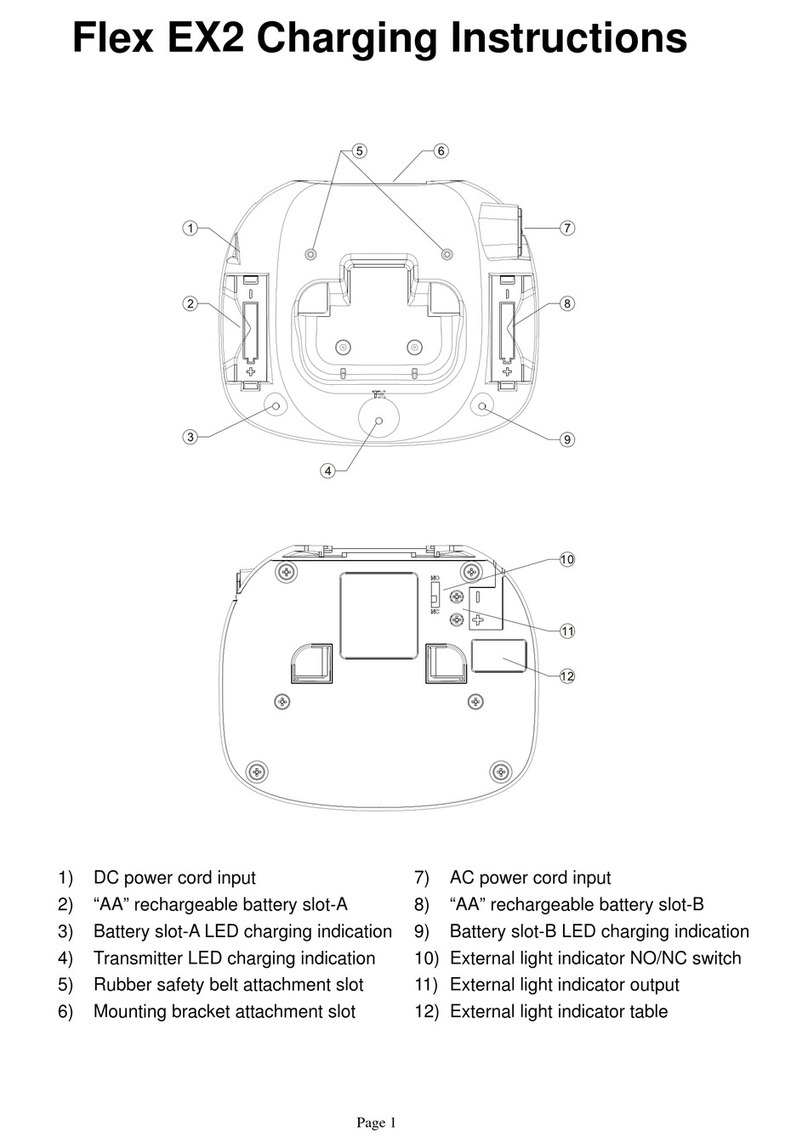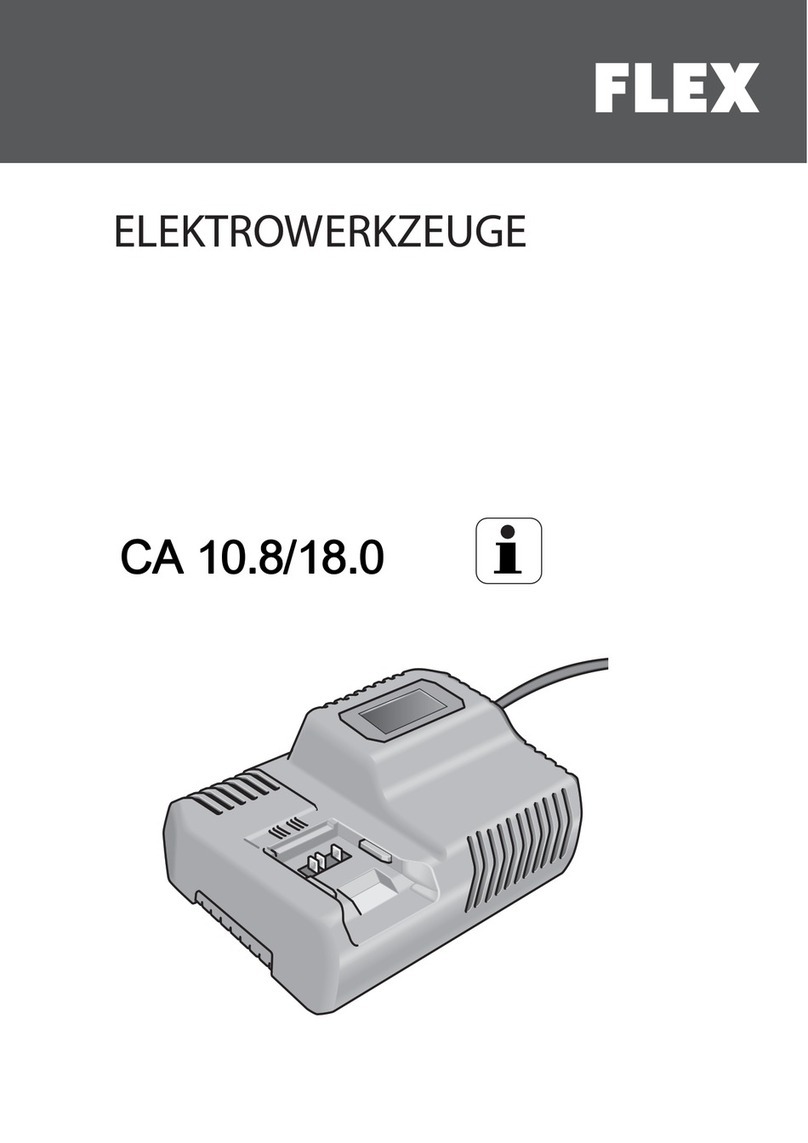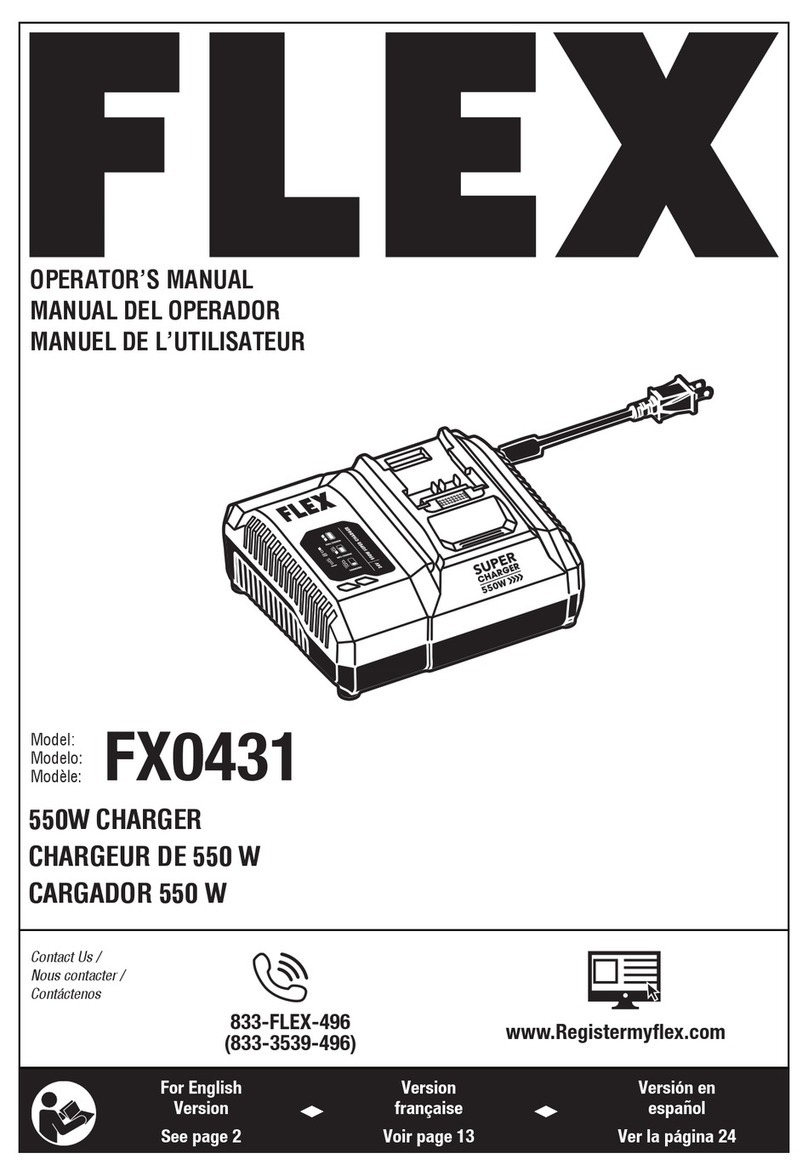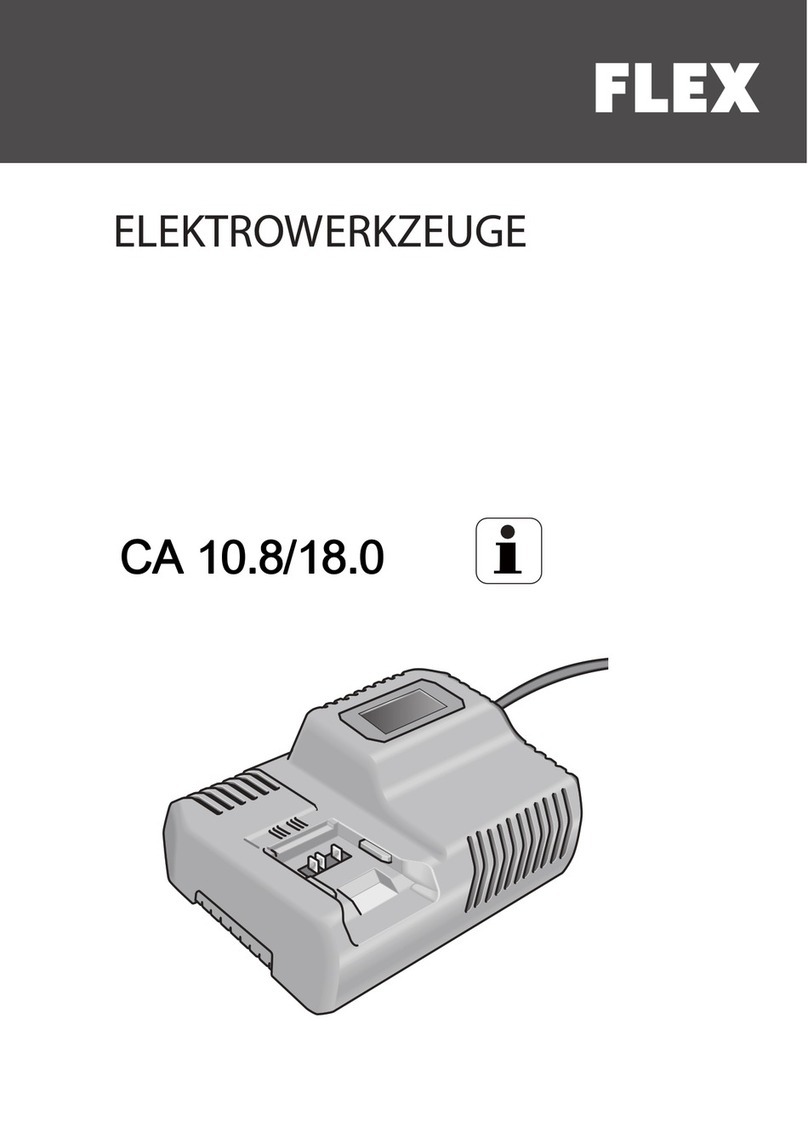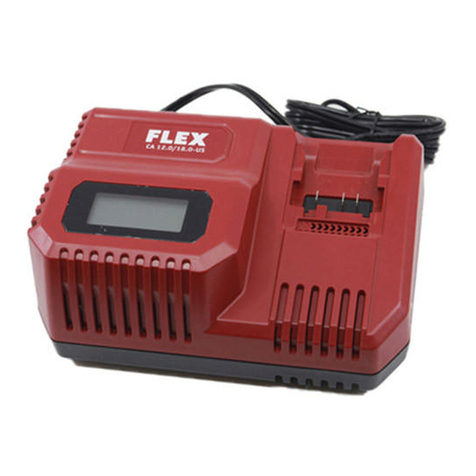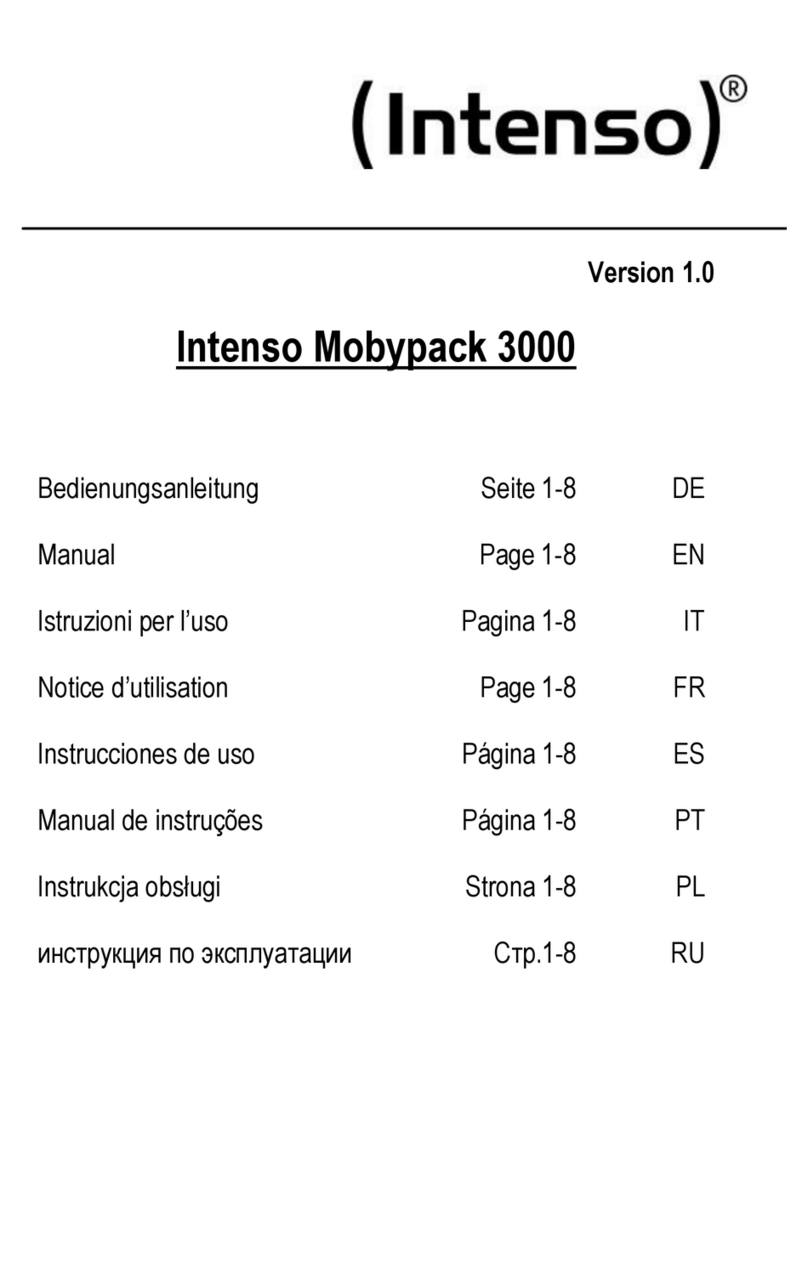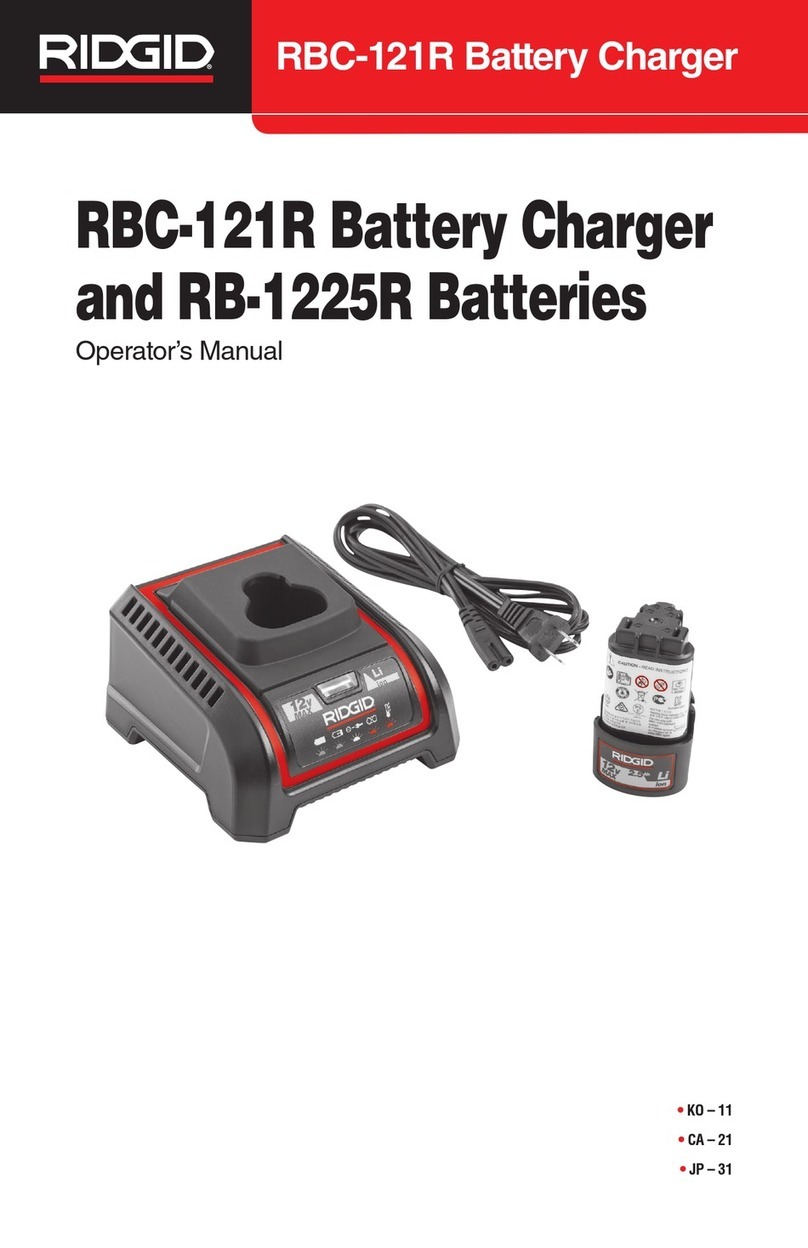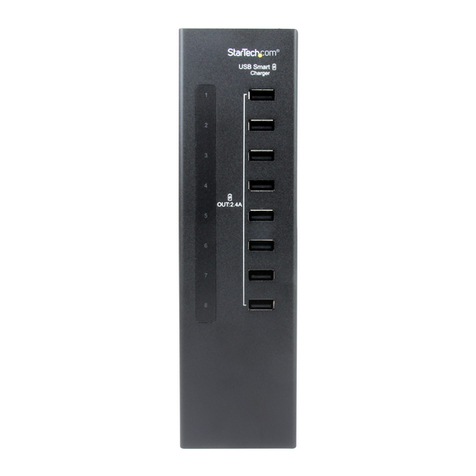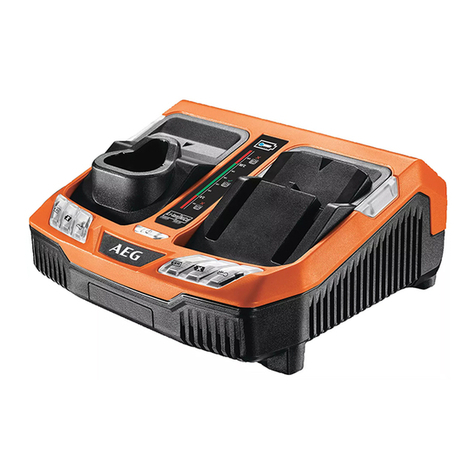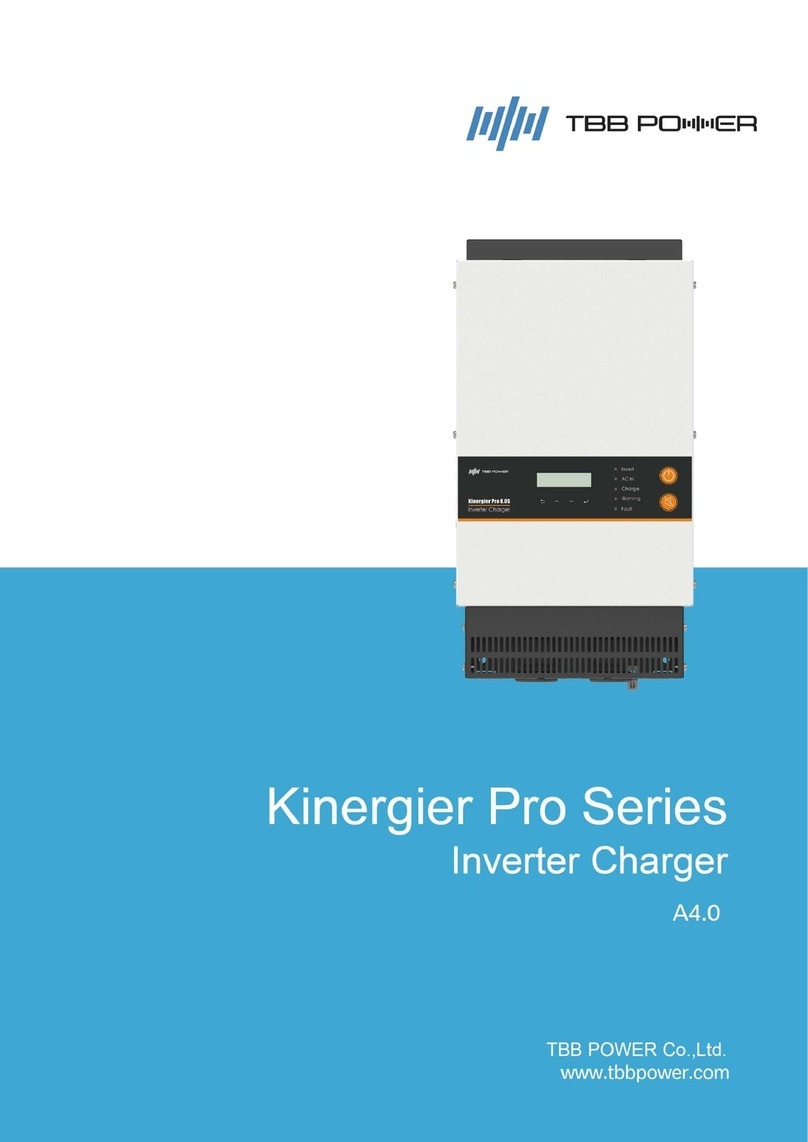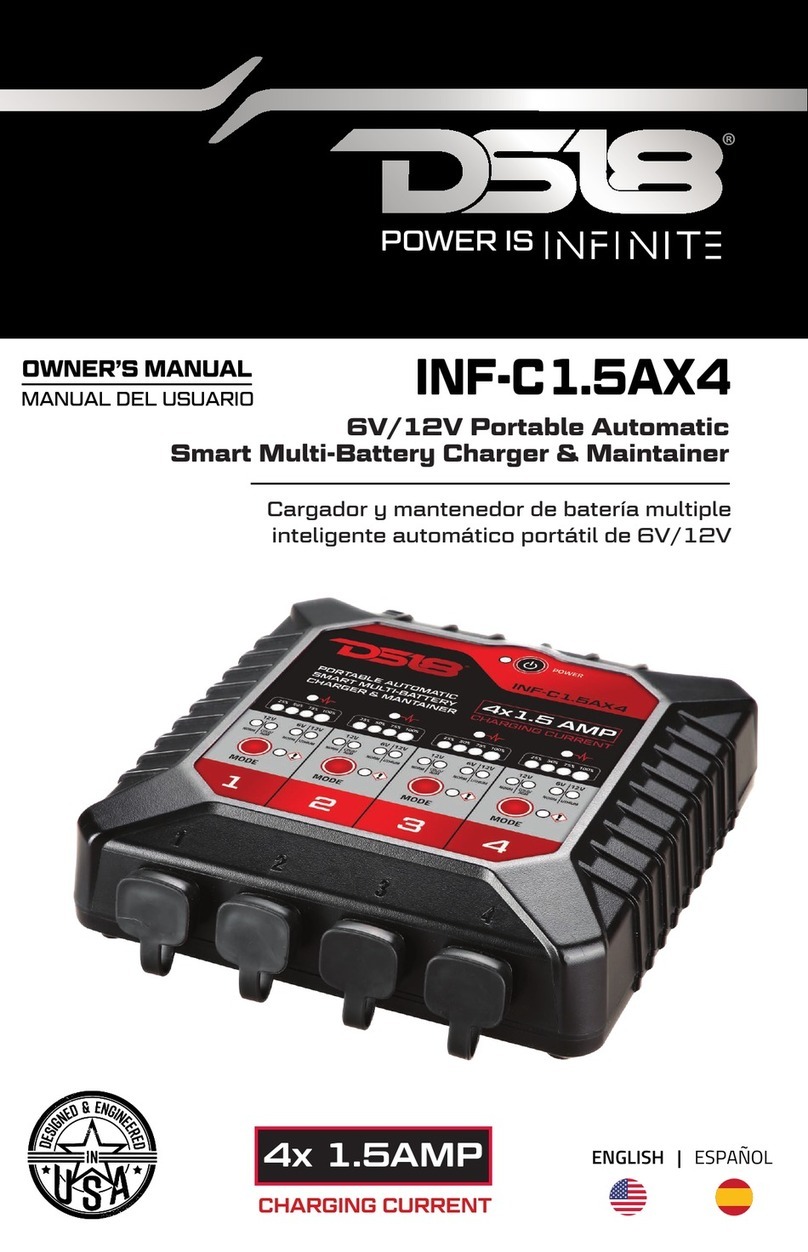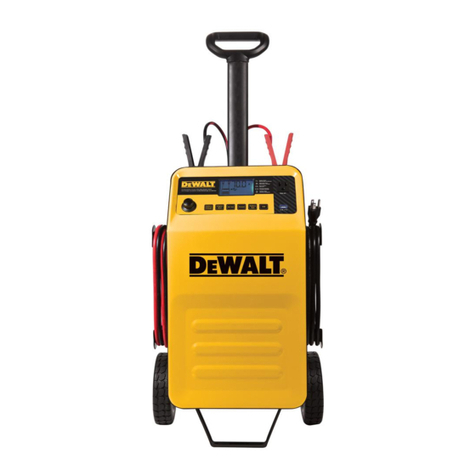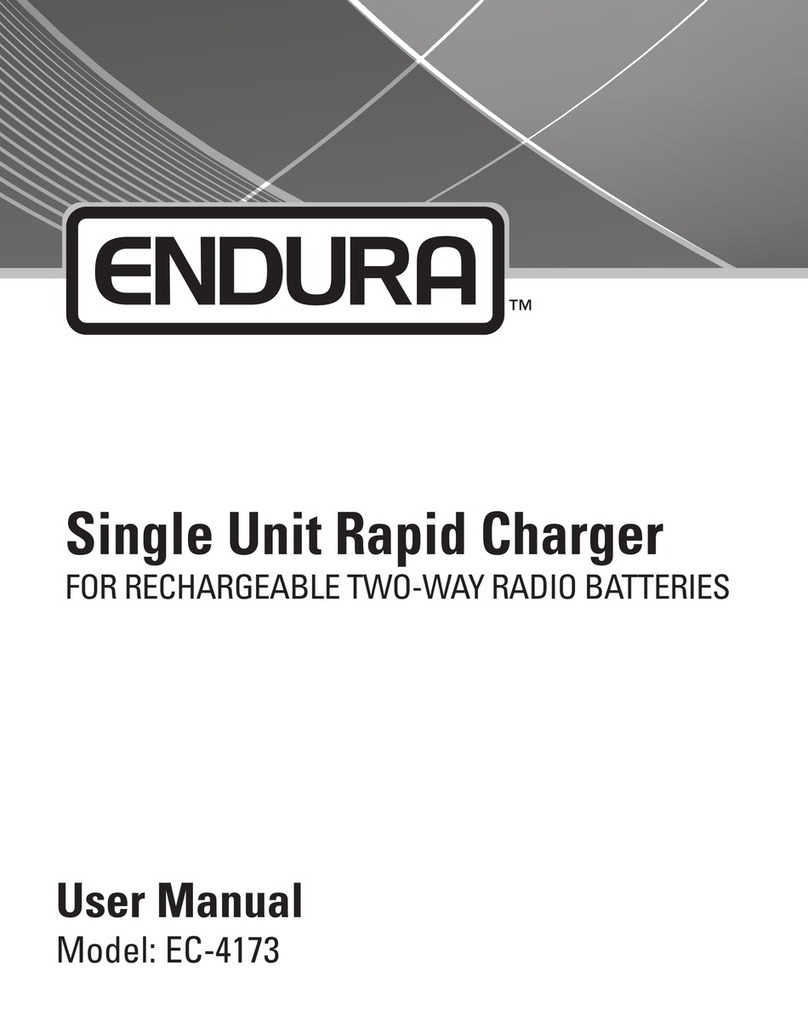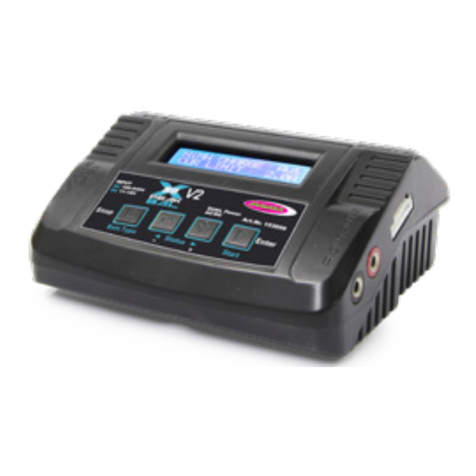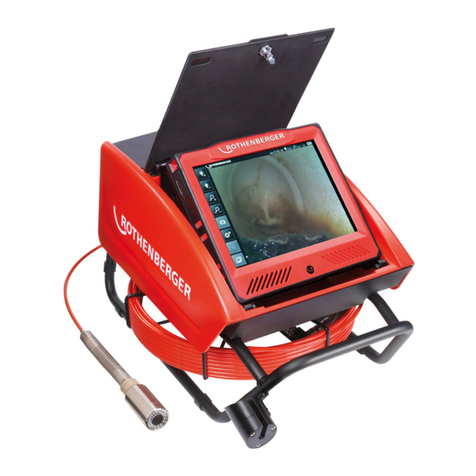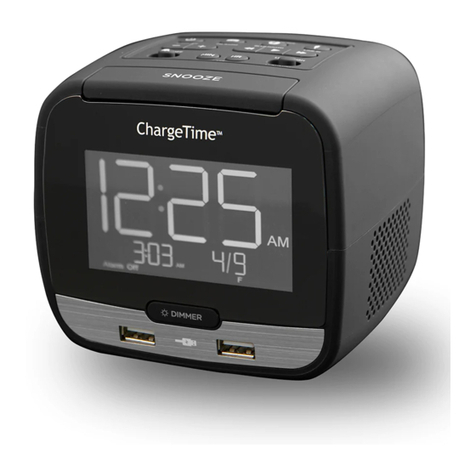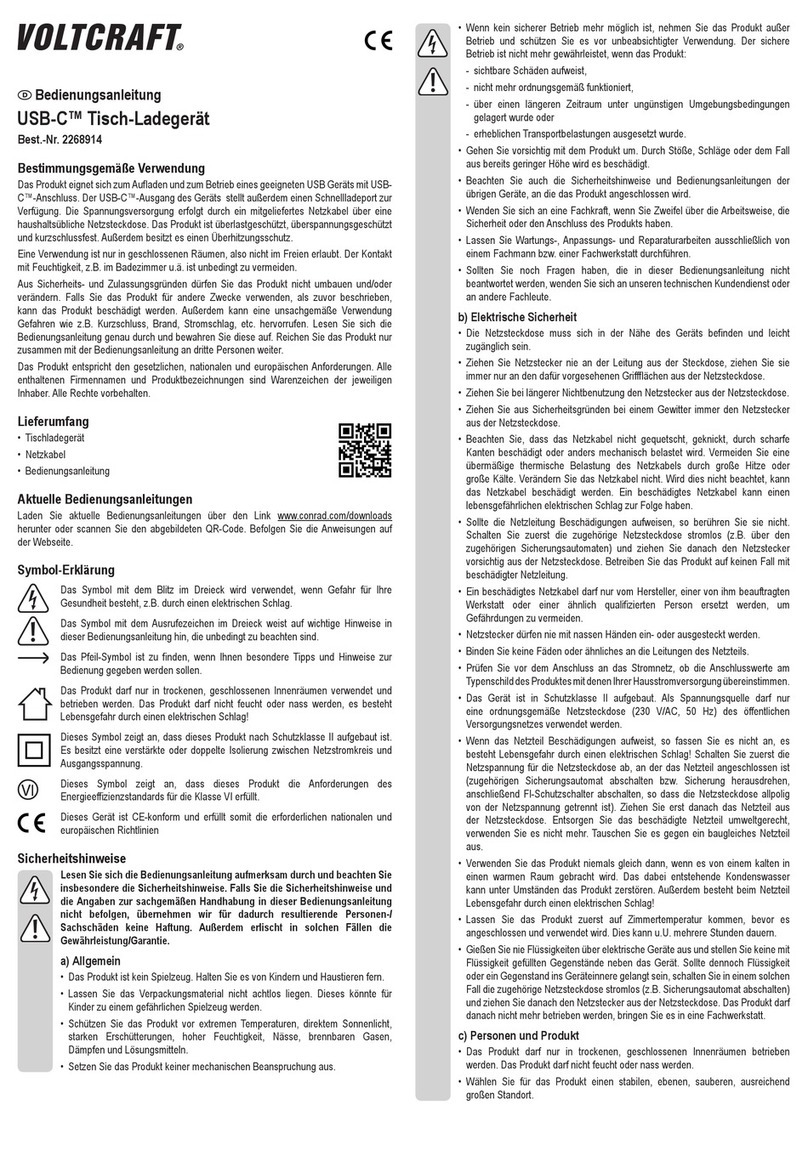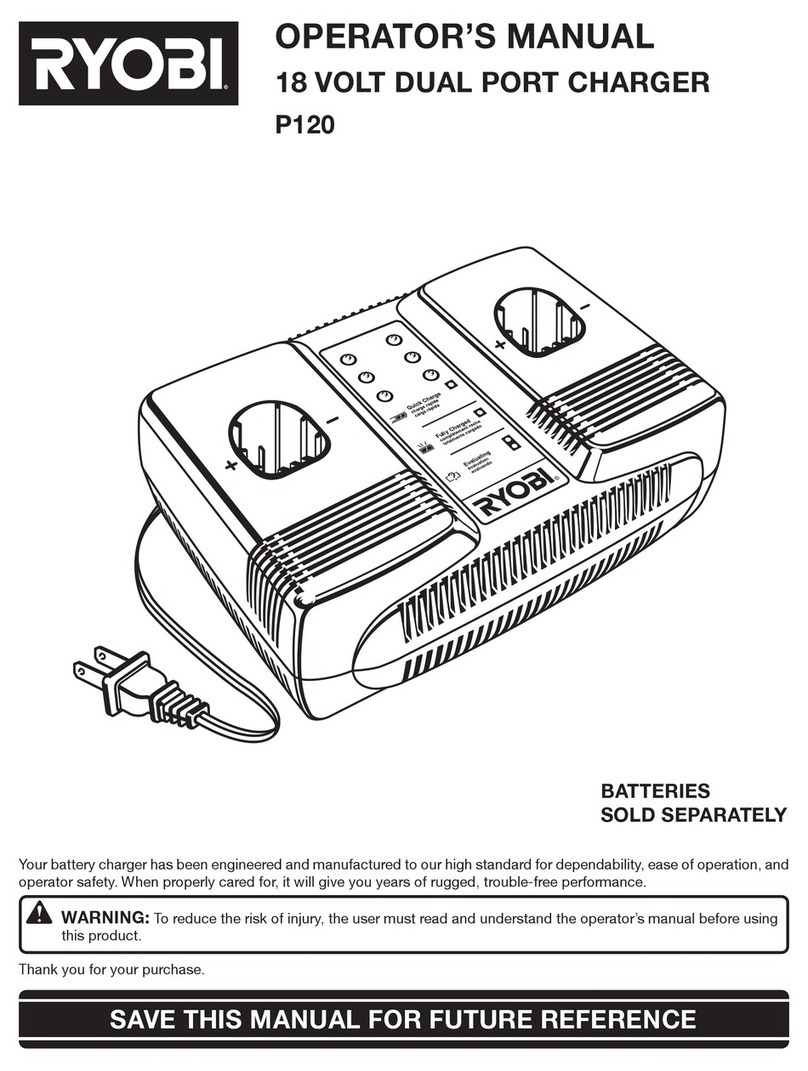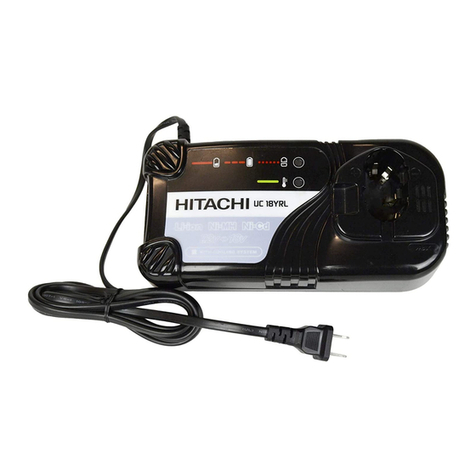Flex FX0411 User manual

Model:
Modelo:
Modèle:
OPERATOR’S MANUAL
MANUAL DEL OPERADOR
MANUEL DE L’UTILISATEUR
833-FLEX-496
(833-3539-496)
For English
Version
See page 2
◆
Version
française
Voir page 16
◆
Versión en
español
Ver la página 30
www.Registermyex.com
Contact Us /
Nous contacter /
Contáctenos
160W 24V CHARGER
CHARGEUR DE 160 W, 24 V
CARGADOR DE 160 W Y 24 V
FX0411

-2-
SAFETY SYMBOLS
The purpose of safety symbols is to attract your attention to possible dangers. The safety symbols
and the explanations with them deserve your careful attention and understanding. The symbol
warnings do not, by themselves, eliminate any danger. The instructions and warnings they give are
no substitutes for proper accident prevention measures.
WARNING Be sure to read and understand all safety instructions in this Owner's Manual,
including all safety alert symbols such as "DANGER," "WARNING," and
"CAUTION" before using this tool. Failure to follow all instructions listed below may result in electric
shock, re, and/or serious personal injury.
The denitions below describe the level of severity for each signal word. Please read the manual and
pay attention to these symbols.
This is the safety alert symbol. It is used to alert you to potential personal
injury hazards. Obey all safety messages that follow this symbol to avoid
possible injury or death.
DANGER DANGER indicates a hazardous situation which, if not avoided, will result in
death or serious injury.
WARNING WARNING indicates a hazardous situation which, if not avoided, could result
in death or serious injury.
CAUTION CAUTION, used with the safety alert symbol, indicates a hazardous situation
which, if not avoided, will result in minor or moderate injury.
Damage Prevention and Information Messages
These inform the user of important information and/or instructions that could lead to equipment or
other property damage if they are not followed. Each message is preceded by the word "NOTICE",
as in the example below:
NOTICE: Equipment and/or property damage may result if these instructions are not followed.
WARNING The operation of any power tools can result in foreign
objects being thrown into your eyes, which can result in
severe eye damage. Before beginning power tool operation, always wear
safety goggles or safety glasses with side shields and a full face shield when
needed. We recommend a Wide Vision Safety Mask for use over eyeglasses
or standard safety glasses with side shields. Always use eye protection which
is marked to comply with ANSI Z87.1.

-3-
IMPORTANT SAFETY INSTRUCTIONS
SAVE THESE INSTRUCTIONS –
This manual contains important safety and
operating instructions for battery charger
Models FX0411.
Before using battery charger, read all
instructions and cautionary markings on
(1) battery charger, (2) battery pack, and (3)
product using battery.
CAUTION To reduce risk of injury,
charge only Li-Ion type
rechargeable batteries. Other types of
batteries may burst causing personal injury
and damage.
Charge battery pack within the required
temperature range. Store charger and
battery pack in locations where temperature
is within the recommended storage
temperature range. This is important to prevent
serious damage to the battery cells.
Do not recharge battery in damp or wet
environment. Do not expose charger to rain
or snow. Water entering battery charger may
result in electric shock or re.
Battery leakage may occur under extreme
usage or temperature conditions. Avoid
contact with skin and eyes. The battery liquid
is caustic and could cause chemical burns to
tissues. If liquid comes in contact with skin,
wash quickly with soap and water. If the liquid
contacts your eyes, ush them with water for
a minimum of 10 minutes and seek medical
attention.
Place charger on at nonammable surfaces
and away from ammable materials when
recharging battery pack. Carpeting and
other heat insulating surfaces block proper air
circulation which may cause overheating of the
charger and battery pack. If smoke or melting
of the charger or battery pack is observed,
unplug the charger immediately and do not use
the battery pack or charger. Contact customer
service immediately.
Keep the cord and charger from heat to
prevent damage to housing or internal parts.
Do not allow gasoline, oils, petroleum-based
products, etc. to come in contact with plastic
parts. These materials contain chemicals that
can damage, weaken, or destroy plastic.
Make sure cord is located so that it will not
be stepped on, tripped over, or otherwise
subjected to damage or stress. Damaged plug
and cord may result in electric shock or re.
Disconnect the charger by pulling the plug
rather than the cord. Do not operate charger
with damaged cord or plug; have them
replaced immediately. Damaged plug or cord
may result in electric shock or re.
Do not insert battery pack in charger if
battery pack case is cracked. Using damaged
battery pack may result in electric shock or re.
Do not disassemble charger or operate the
charger if it has received a sharp blow, been
dropped or otherwise damaged in anyway.
Incorrect reassembly or damage may result in
electric shock or re.
Before each use, check the battery charger,
cable and plug. If damage is detected, do
not use the battery charger. Never open
the battery charger yourself, take it to a
FLEX Factory Service Center, or qualied
serviceman only using original spare parts.
Incorrect reassembly may result in electric
shock or re.
Do not touch the uninsulated portion of
output connector or uninsulated battery
terminal. There is a risk of electric shock.
Do not use attachment not recommended
or sold by FLEX. Using attachments not
recommended may result in electric shock or
re.
Do not store battery pack in charger. Battery
pack stored in charger over a long period of
time could lead to battery pack damage and re.
Unplug charger from outlet before storage,
attempting any maintenance or cleaning.
Such preventive safety measures reduce the
risk of electric shock or re.
Keep the battery charger clean by blowing
compressed air on charger vents and wiping
the charger housing with a damp cloth.
Contamination may result in electric shock or
re.
Replace battery pack if a substantial drop
in operating time per charge is observed.
Battery pack may be nearing the end of its life.

-4-
To reduce the risk of injury, close
supervision is necessary when an appliance
is used near children.
Do not use outdoors.
SAVE THESE INSTRUCTIONS.
EXTENSION CORDS
WARNING AN EXTENSION CORD
SHOULD NOT BE USED
UNLESS ABSOLUTELY NECESSARY. Use of
improper extension cord could result in risk of
re and electrical shock. If an extension cord is
used, make sure:
a. The pins on plug of extension cord are the
same number, size, and shape as those of
plug on charger.
b. The extension cord is properly wired and in
good electrical condition.
c. The wire size is large enough for AC ampere
rating of charger as specied below:
Length of Cord (Feet) 25 50 100 150
Size of Cord (AWG) 18 16 16 14
Extension Cord Chart for 220/240 Volt Tools:
0.75mm2CORD 50 Meters
1.0mm2CORD 75 Meters
d. An extension cord is a temporary solution. Move the charger to a standard receptacle as soon as
the job has been completed.
FCC CAUTION
1. This device complies with Part 15 of the FCC
Rules. Operation is subject to the following
two conditions:
(1) This device may not cause harmful
interference.
(2) This device must accept any interference
received, including interference that may
cause undesired operation.
2. Changes or modications not expressly
approved by the party responsible for
compliance could void the user’s authority to
operate the equipment.
NOTE: This equipment has been tested and
found to comply with the limits for a Class
B digital device, pursuant to Part 15 of the
FCC Rules. These limits are designed to
provide reasonable protection against harmful
interference in a residential installation. This
equipment generates, uses, and can radiate
radio frequency energy and, if not installed
and used in accordance with the instructions,
may cause harmful interference to radio
communications.
However, there is no guarantee that interference
will not occur in a particular installation. If this
equipment does cause harmful interference
to radio or television reception, which can be
determined by turning the equipment off and
on, the user is encouraged to try to correct the
interference by one or more of the following
measures:
• Reorient or relocate the receiving antenna.
• Increase the separation between the
equipment and receiver.
• Connect the equipment into an outlet on a
circuit different from that to which the receiver
is connected.
• Consult the dealer or an experienced radio/TV
technician for help.

-5-
WARNING People with electronic
devices, such as
pacemakers, should consult their
physician(s) before using this product.
Operation of electrical equipment in close
proximity to a heart pacemaker could cause
interference or failure of the pacemaker.
WARNING
• Some dust created by power sanding, sawing,
grinding, drilling and other construction
activities contains chemicals known to the
State of California to cause cancer, birth
defects or other reproductive harm. Some
examples of these chemicals are:
– Lead from lead-based paints.
– Crystalline silica from bricks, cement, and
other masonry products.
– Arsenic and chromium from chemically-treated
lumber.
• Your risk from these exposures varies,
depending upon how often you do this type
of work. To reduce your exposure to these
chemicals:
– Work in a well-ventilated area.
– Work with approved safety equipment, such
as dust masks that are specially designed to
lter out microscopic particles.
– Avoid prolonged contact with dust from power
sanding, sawing, grinding, drilling, and other
construction activities. Wear protective clothing
and wash exposed areas with soap and water.
Allowing dust to get into your mouth or eyes or
to lie on the skin may promote absorption of
harmful chemicals.

-6-
SYMBOLS
IMPORTANT: Some of the following symbols may be used on your tool. Please study them and
learn their meaning. Proper interpretation of these symbols will allow you to operate the tool better
and safer.
Symbol Name Designation/Explanation
V Volts Voltage
A Amperes Current
Hz Hertz Frequency (cycles per second)
W Watt Power
kg Kilograms Weight
min Minutes Time
s Seconds Time
Wh Watt-hours Battery capacity
Ah Ampere-hours Battery capacity
ø Diameter Size of drill bits, grinding wheels, etc.
n0No load speed Rotational speed, at no load
n Rated speed Maximum attainable speed
…/min Revolutions or reciprocations per
minute (rpm)
Revolutions, strokes, surface speed, orbits,
etc. per minute
O Off position Zero speed, zero torque...
1,2,3,…
Ⅰ,Ⅱ,Ⅲ, Selector settings Speed, torque, or position settings. Higher
number means greater speed
Innitely variable selector with off Speed is increasing from 0 setting
Arrow Action in the direction of arrow
Alternating current (AC) Type or a characteristic of current
Direct current (DC) Type or a characteristic of current
Alternating or direct current
(AC / DC) Type or a characteristic of current
Class II tool Designates Double Insulated Construction
tools.
Protective earth Grounding terminal
Li-ion RBRC seal Designates Li-ion battery recycling
program
Read the instructions Alerts user to read manual

-7-
Symbol Name Designation/Explanation
Wear eye protection symbol Alerts user to wear eye protection
Always operate with two hands Alerts user to always operate with two
hands
Do not use the guard for cut-off
operations Do not use the guard for cut-off operations
SYMBOLS (CERTIFICATION INFORMATION)
Symbol Designation/Explanation
This symbol designates that this tool is listed by Underwriters Laboratories.
This symbol designates that this component is recognized by Underwriters
Laboratories.
This symbol designates that this tool is listed by Underwriters Laboratories, to
United States and Canadian Standards.
This symbol designates that this tool is listed by the Canadian Standards
Association.
This symbol designates that this tool is listed by the Canadian Standards
Association, to United States and Canadian Standards.
This symbol designates that this tool is listed by the Intertek Testing Services,
to United States and Canadian Standards.

-8-
FUNCTIONAL DESCRIPTIONS AND SPECIFICATIONS
Charger
Fig. 1
Power Cord
Red/green LED Indicator Green LED Indicator
Electrical Contacts
Rated Input 120V AC, 60Hz, 160W
Rated Output 24V
Battery Compatibility 2.5Ah
FX0111
5Ah
FX0121
8Ah
FX0221
12Ah
FX0231
Approximate
Charging Time
(minutes)
80% 100% 80% 100% 80% 100% 80% 100%
25 30 50 60 75 90 120 140
Recommended
Charging
Temperature
38 - 122°F (3 - 50℃)
Recommended
Storage Temperature < 122℉ (< 50℃)
NOTE: All charging times are subject to environmental temperature and the battery pack condition.

-9-
IMPORTANT CHARGING NOTES
1. A substantial drop in operating time per
charge may mean that the battery pack is
nearing the end of its life and should be
replaced.
2. Remember to unplug the charger during
storage.
3. If battery does not charge properly:
a. Check for power at the outlet by plugging
another electrical device into the outlet.
b. Check to see if outlet is connected to a light
switch that turns power “off” when the lights
are turned off.
c. Check the battery pack terminals for dirt.
Clean with a cotton swab and alcohol, if
necessary.
d. If proper charging still does not occur, take
or send the tool, battery pack and charger to
your local FLEX Service Center. Please refer
to the Customer Service information on the
cover of this manual.
NOTICE: Use of chargers or battery packs not
sold by FLEX will void the tool warranty.
OPERATING INSTRUCTIONS
WARNING To reduce the risk of re,
personal injury, and
product damage due to a short circuit, never
immerse your charger or battery pack in
uid or allow a uid to ow inside them.
Corrosive or conductive uids, such as
seawater, certain industrial chemicals, and
bleach or bleach-containing products, etc. can
cause a short circuit.
WARNING Do not attempt to modify
the charger or create
accessories not recommended for use with
this charger. Any such alteration or
modication is misuse and could result in a
hazardous condition leading to possibly serious
personal injury.
HOW TO CHARGE THE BATTERY PACK
(FIG. 2)
WARNING Do not use the charger
outdoors or expose it to
wet or damp conditions. Water entering the
charger will increase the risk of electric shock.
NOTICE: Lithium-Ion battery packs are shipped
partially charged. Before using it the rst time,
fully charge the battery pack.
a. Connect the charger to the power supply
(120V~, 60Hz). When connected to the power
supply, the green and red LED indicators on
the charger will ash once at the same time
and then go out, indicating that the charger
self-inspection is completed.
b. Align the raised ribs of the battery pack with
the slots in the charger and slide the battery
pack onto the charger.
c. The charger will communicate with the battery
pack to evaluate the condition of the battery
pack.
Fig. 2

-10-
Battery Pack Charge Status Power Indicator
<25%
Last segment ashing, the
rest are solid
25%-50%
50%-75%
≥75%
d. When the battery pack is charging, the
green LED will ash. The power indicator
on the battery will ash according to the
current capacity level. The fan in the charger
continuously works to cool the battery pack.
e. Once the battery is 80% charged, the green
LED shows solid green, the red/green LED
starts ashing green. When the battery pack
is fully charged, the red/green LED will remain
green without ashing. The power indicator
on the battery pack will go out.
f. The battery pack will fully charge if left on the
charger, but it will not overcharge.
NOTICE: A signicantly reduced run time after
fully charging the battery pack indicates that
the battery is near the end of its usable life and
must be replaced.
The charger may become warm during
charging. This is part of the normal operation of
the charger. Charge in a well-ventilated area.
Charger Display
Mode Green LED on
the Charger Red/Green LED
on the Charger
Power Indicator
on the Battery
pack Note
Self-inspection
completed Flashing once Flashing red
once Off
Red and Green
LED ash once at
the same time
Self-inspection
failed Off Off Off
No reaction when
the charger is
plugged in
Standby Off Off Off
Plugged in; battery
pack is not on the
charger
Charging
Flashing Off Flashing
according to the
current capacity
level.
Battery is less than
80% charged
Steady Flashing green Battery is 80%
charged
Full Charge Steady Steady Off
Cold/Hot Battery Off Steady Off
Remove the
battery pack from
the charger
Defective Off Flashing red or
off Off
Battery pack
or charger is
defective

-11-
CHARGING A HOT OR COLD BATTERY
PACK
A steady red LED indicates that the battery is
over or under the optimal temperature. Remove
the battery pack from the charger. If the battery
is too hot, cool the battery under air ow. If
the battery is too cold, place it indoors until it
reaches room temperature.
DEFECTIVE CHARGER
If the charger self-inspection fails to react when
the charger is plugged in, the causes include
no power to the charger, bad contacts, or a
defective charger. Check to see if the charger
self-inspection can be activated when the
charger is plugged in again or plugged into a
different outlet. If it still fails, have the charger
serviced by an Authorized FLEX Service
Station.
DEFECTIVE BATTERY PACK
If the charger detects a problem, the red/green
LED will begin ashing red. Remove and
re-insert the battery pack in the charger. If the
red/green LED still ashes red, try charging a
different battery pack.
a)If a different battery pack charges normally,
have the rst defective battery pack serviced
by an Authorized FLEX Service Station.
b)If a different battery pack also indicates
“defective,” the charger may be defective.
Have the charger serviced by an Authorized
FLEX Service Station.
WALL-MOUNT HOLES (FIG. 3)
The charger has wall-mount holes for
convenient storage. Install screws in the wall 3
inches (76mm) apart. Use screws sufciently
strong to hold the combined weight of the
charger and battery pack.
Fig. 3 Wall-mount Holes

-12-
MAINTENANCE
SERVICE
WARNING Preventive maintenance
performed by
unauthorized personnel may result in
misplacing of internal wires and
components which could cause serious
hazard. We recommend that all tool service be
performed by a FLEX Factory Service Center or
Authorized FLEX Service Station.
GENERAL MAINTENANCE
WARNING When servicing, use only
identical replacement
parts. Use of any other parts could create a
hazard or cause product damage.
Periodically inspect the entire product for
damaged, missing, or loose parts such as
screws, nuts, bolts, caps, etc. Securely tighten
all fasteners and caps and do not operate this
product until all missing or damaged parts are
replaced. Please contact customer service or an
authorized service center for assistance.
WARNING To avoid serious personal
injury, always remove the
battery pack from the charger/tool when
cleaning or performing any maintenance.
CLEANING
WARNING The tool may be cleaned
most effectively with
compressed dry air. Always wear safety
goggles when cleaning tools with
compressed air.
Ventilation openings and switch selectors must
be kept clean and free of foreign matter. Do not
attempt to clean by inserting pointed objects
through openings.
WARNING Certain cleaning agents
and solvents damage
plastic parts. Some of these are: gasoline,
carbon tetrachloride, chlorinated cleaning
solvents, ammonia and household detergents
that contain ammonia.
STORAGE
Store the tool indoors in a place that is
inaccessible to children. Keep away from
corrosive agents.

-13-
FLEX 5 YEAR LIMITED WARRANTY
Chervon North America, Inc. ("Seller") warrants to the original purchaser only, that all FLEX 24V
products will be free from defects in material or workmanship for a period of ve years from date of
purchase when the original purchaser registers the product within 30 days from the date of original
retail purchase and retains their receipt as proof of purchase. THE 5-YEAR LIMITED WARRANTY
PERIOD IS CONDITIONED ON REGISTRATION OF THE PRODUCT WITHIN 30 DAYS OF
PURCHASE AND ONLY APPLICABLE TO FLEX 24V TOOLS, BATTERIES AND CHARGERS. If the
original purchaser does not register their product within 30 days, the foregoing limited warranty will
apply for a duration of three years. Product registration can be completed online at
www.registermyex.com.
24V Tools: 5-Year Limited Warranty with Registration
24V Batteries and Chargers: 5-Year Limited Warranty with Registration
Corded, 12V and 20V FLEX Legacy Products: 1-Year Limited Warranty, No Registration Benet
Accessories and Attachments: No Warranty
SELLER’S SOLE OBLIGATION AND YOUR EXCLUSIVE REMEDY under this 5-Year Limited
Warranty and, to the extent permitted by law, any warranty or condition implied by law, shall be
the repair or replacement of parts, without charge, which are defective in material or workmanship
and which have not been misused, carelessly handled, or repaired by persons other than a FLEX
Authorized Service Dealer. This warranty does not cover part failure due to normal wear and tear.
To make a claim under warranty, return the complete product, transportation prepaid, to any FLEX
Authorized Service Dealer. For Authorized FLEX Service Dealers, please visit www.registermyex.com
or call 1-833-FLEX-496 (1-833-353-9496).
This 5-Year Limited Warranty does not apply to accessories, attachments or parts.
Any implied warranties applicable to a product shall be limited in duration equal to the duration of the
express warranties applicable to such product, as set forth in the rst paragraph above. Some states
in the U.S. and some Canadian provinces do not allow limitations on how long an implied warranty
lasts, so the above limitation may not apply.
FLEX is not responsible for direct, indirect, incidental or consequential damages. Some U.S. states
and Canadian provinces do not allow limitations on how long an implied warranty lasts and/or do
not allow the exclusion or limitation of incidental or consequential damages, so the above limitations
or exclusions may not apply. This limited warranty gives you specic legal rights, and you may also
have other rights which vary by state in the U.S. and by province in Canada.
This limited warranty applies only to products sold within the United States of America, Canada and
the commonwealth of Puerto Rico. For warranty coverage within other countries, contact your local
FLEX dealer.
© Chervon North America, 1203 E. Warrenville Rd., Naperville, IL 60563
www.expowertools.com
www.registermyex.com
1-833-FLEX-496 (1-833-353-9496)

-14-
SYMBOLES DE SÉCURITÉ
L’objectif des symboles de sécurité est d’attirer votre attention sur les dangers potentiels. Vous
devez examiner attentivement et bien comprendre les symboles de sécurité et les explications qui
les accompagnent. Les symboles d’avertissement en tant que tels n’éliminent pas le danger. Les
consignes et les avertissements qui y sont associés ne remplacent en aucun cas des mesures
préventives adéquates.
AVERTISSEMENT Avant d’utiliser cet outil, assurez-vous de lire et de comprendre toutes
les consignes de sécurité présentées dans le présent guide
d’utilisation, notamment toutes les consignes de sécurité indiquées par les mentions « DANGER »,
« AVERTISSEMENT » et « MISE EN GARDE ». Le non-respect des consignes qui suivent peut
entraîner un choc électrique, un incendie ou des blessures graves.
Les dénitions ci-dessous décrivent le degré de gravité pour chaque mot-indicateur. Veuillez lire ce
manuel et prêter attention à ces symboles.
Voici le pictogramme d’alerte de sécurité. Il sert à vous indiquer les
risques potentiels de blessures. Respectez toutes les consignes
de sécurité associées à ce pictogramme pour éviter les risques de
blessures ou de mort.
DANGER La mention DANGER indique un danger imminent qui, s’il n’est pas
évité, causera des blessures graves ou la mort.
AVERTISSEMENT La mention AVERTISSEMENT indique un risque pouvant entraîner
des blessures graves ou la mort s’il n’est pas prévenu.
MISE EN GARDE La mention MISE EN GARDE, utilisée avec le symbole d’alerte
de sécurité, indique un risque potentiel qui, s’il n’est pas éliminé,
provoquera des blessures mineures ou moyennement graves.
Messages d’information et de prévention des dommages
Ces messages fournissent à l’utilisateur de l’information et des consignes importantes. Les ignorer
pourrait occasionner des dommages à l’équipement ou d’autres dommages matériels. Chaque
message est précédé du mot « AVIS », comme dans l’exemple ci-dessous :
AVIS : Ne pas suivre ces consignes pourrait occasionner des dommages à l’équipement ou d’autres
dommages matériels.
AVERTISSEMENT L’utilisation de tout outil électrique peut
entraîner la projection de corps étrangers dans
les yeux et ainsi causer des lésions oculaires graves. Avant d’utiliser un outil
élec-trique, veillez à toujours porter des lunettes de sécurité étanches ou à
écrans latéraux, ou un masque de protection complet au besoin. Nous
recommandons le port d’un masque de sécurité panoramique par-dessus les
lunettes ou de lu-nettes de sécurité standard avec écrans latéraux. Portez
toujours des protecteurs oculaires conformes à la norme ANSI Z87.1.

-15-
CONSIGNES DE SÉCURITÉ IMPORTANTES
CONSERVER CES INSTRUCTIONS – Ce
mode d’emploi contient des consignes de
sécurité et des instructions d’utilisation
importantes pour le chargeur de piles
modèle FX0411.
Avant d’utiliser le chargeur de piles, lisez
toutes les instructions et toutes les mises en
garde sur (1) le chargeur de piles, (2) le bloc-
piles et (3) le produit utilisant la pile.
MISE EN GARDE Pour réduire le
risque de
blessure, n’utilisez que des piles de type
Li-Ion rechargeables. Les autres types de
piles pourraient éclater et causer des
blessures et des dommages matériels.
Chargez le bloc-piles en restant dans la
plage de température indiquée. Rangez
le chargeur et le bloc-piles à des endroits
où la température est dans la plage de
température de stockage recommandée.
Ceci est important pour éviter de graves
dommages aux cellules des piles.
Ne rechargez pas la pile dans un
environnement humide ou mouillé.
N’exposez pas le chargeur à la pluie ou
à la neige. La pénétration d’eau à l’intérieur
du chargeur de piles pourrait causer un choc
électrique ou un incendie.
Une fuite des piles peut se produire dans
des conditions extrêmes d’utilisation ou de
température. Évitez tout contact avec les yeux
et la peau. Le liquide des piles est caustique
et pourrait causer des brûlures chimiques des
tissus. Si du liquide entre en contact avec la
peau, lavez immédiatement avec de l’eau et du
savon. Si du liquide entre en contact avec les
yeux, rincez-les avec de l’eau pendant au moins
10 minutes et consultez un médecin.
Placez le chargeur sur des surfaces plates
et non inammables, et à distance de
tout matériau inammable, lorsque vous
rechargez le bloc-piles. La moquette et les
autres surfaces isolantes thermiques bloquent
la circulation de l’air, ce qui peut provoquer
une surchauffe du chargeur et du bloc-piles. Si
vous voyez de la fumée ou constatez la fusion
du chargeur ou du bloc-piles, débranchez
immédiatement le chargeur et n’utilisez
pas le bloc-piles ou le chargeur. Contactez
immédiatement le service à la clientèle.
Gardez le cordon et le chargeur à distance
de toute source de chaleur pour éviter
d’endommager le boîtier ou les pièces
internes.
Ne laissez pas d’essence, d‘huiles, de
produits à base de pétrole, etc. entrer en
contact avec des pièces en plastique. Ces
matériaux contiennent des agents chimiques
qui pourraient endommager, affaiblir ou détruire
le plastique.
Placez le cordon de sorte qu’il ne soit
pas piétiné, qu’il ne fasse pas trébucher
des passants ou qu’il ne soit pas soumis
par ailleurs à des dommages ou à des
contraintes. Une che ou un cordon
endommagé pourrait causer un choc électrique
ou un incendie.
Débranchez le chargeur en tirant sur la che,
et non sur le cordon lui-même. N’utilisez pas
le bloc d’alimentation et le chargeur si la
che ou le cordon est endommagé ; faites-
les remplacer immédiatement. Une che ou
un cordon endommagé pourrait causer un choc
électrique ou un incendie.
N’insérez pas un bloc-piles dans le chargeur
si le conditionnement du bloc-piles est
ssuré. L’utilisation d’un bloc-piles endommagé
pourrait causer un choc électrique ou un
incendie.
Ne démontez pas le chargeur et ne
l’utilisez pas s’il a reçu un coup violent,
s’il est tombés ou s’il a été endommagée
d’une quelconque autre manière. Un
remontage incorrect ou l’utilisation d’un produit
endommagé pourrait causer un choc électrique
ou un incendie.
Inspectez le chargeur de piles, le câble
et la che avant chaque emploi. Si vous
constatez un dommage quelconque,
n’utilisez pas le chargeur de piles. N’ouvrez
jamais le chargeur de piles vous-même ;
apportez-le dans un centre de service
usine FLEX ou chez un réparateur qualié
n’utilisant que des pièces de rechange
d’origine. Un remontage incorrect pourrait
causer un choc électrique ou un incendie.
Ne touchez pas la partie non isolée du
connecteur de sortie ou une borne non
isolée du boc-piles. Il existe un risque de choc
électrique.

-16-
N’utilisez pas d’attachements qui ne sont
pas recommandés ou vendus par FLEX.
L’utilisation d’attachements non recommandés
pourrait causer un choc électrique ou un
incendie.
Ne laissez pas le bloc-piles dans le chargeur
pendant une période prolongée. Un bloc-piles
laissé dans un chargeur pendant une période
prolongée risquerait d’être endommagé et de
causer un incendie.
Débranchez le chargeur de la prise de
courant avant de le ranger, de le nettoyer
ou d’effectuer une quelconque opération de
maintenance. De telles mesures de sécurité
préventives réduisent le risque de choc
électrique ou d’incendie.
Assurez-vous que le chargeur de piles
est toujours propre en soufant de l’air
comprimé sur les évents du chargeur et
en essuyant le boîtier du chargeur avec un
chiffon humide. Toute contamination pourrait
causer un choc électrique ou un incendie.
Remplacez le bloc-piles si vous constatez
une réduction substantielle de l’autonomie
de fonctionnement par charge. Il se peut que
le bloc-piles soit proche de la n de sa durée de
vie utile.
Pour réduire le risque de blessure, une
supervision attentive est nécessaire
lorsqu’un outil est utilisé à proximité
d’enfants.
Ne pas utiliser à l’extérieur.
CORDONS DE RALLONGE
AVERTISSEMENT IL NE FAUT PAS
UTILISER DE
CORDON DE RALLONGE À MOINS QUE CE
SOIT ABSOLUMENT NÉCESSAIRE.
L’utilisation d’un cordon de rallonge inapproprié
pourrait causer un incendie et un choc
électrique. Si un cordon de rallonge est
nécessaire, assurez-vous que :
a. Les broches sur la che du cordon de
rallonge ont le même numéro, la même taille
et la même forme que celles de la che du
chargeur.
b. Le cordon de rallonge est câblé correctement
et est en bon état électrique.
c. Le diamètre du l est assez grand pour être
compatible avec l’intensité nominale c.a. du
chargeur, comme indiqué ci-dessous :
Longueur du cordon (en
pieds) 25 50 100 150
Diamètre du cordon (AWG) 18 16 16 14
Tableau des cordons de rallonge pour les outils de 220/240 volts :
Cordon de 0,75 mm2 50 mètres
Cordon de 1,0 mm275 mètres
d. Un cordon de rallonge est une solution temporaire. Déplacez le chargeur et branchez-le dans une
prise standard dès que le projet est terminé.

-17-
MISE EN GARDE DE LA FCC
1. Cet équipement est conforme à la partie 15
des Règlements de la FCC. Son utilisation
est autorisée moyennant le respect des deux
conditions suivantes :
(1) Ce dispositif ne doit pas causer
d’interférences préjudiciables.
(2) Ce dispositif doit accepter toute
interférence reçue, y compris les interférences
qui risquent de causer un fonctionnement
indésirable de l’équipement.
2. Toute modication ou altération de ce
dispositif n’ayant pas été approuvée
expressément par la partie responsable de
la conformité pourrait annuler le droit de
l’utilisateur de se servir de cet équipement.
REMARQUE : Cet équipement a été testé et
jugé conforme aux limites pour un équipement
numérique de Classe B en vertu de la Partie
15 des Règlements de la FCC. Ces limites
sont conçues pour assurer une protection
raisonnable contre les interférences nuisibles
dans une installation résidentielle. Cet
équipement émet, utilise et peut rayonner de
l’énergie de fréquence radio et, s’il n’est pas
installé et utilisé conformément aux instructions,
il pourrait causer des interférences nuisibles
aux communications radio.
Cependant, il n’existe aucune garantie
qu’aucune interférence ne se produira dans une
installation particulière. Si cet équipement cause
des interférences nuisibles pour la réception
de programmes à la radio ou à la télévision,
ce qui peut être déterminé en allumant et en
éteignant à plusieurs reprises l’équipement en
question, l’utilisateur est encouragé à corriger
l’interférence en prenant une ou plusieurs des
mesures suivantes :
• Réorienter ou déplacer l’antenne de réception.
• Augmenter la distance entre l’équipement et le
récepteur.
• Connecter l’équipement à une prise de courant
raccordée à un circuit différent de celui auquel
le récepteur est connecté.
• Consulter le détaillant ou un technicien radio
ou télévision expérimenté pour lui demander
conseil.
AVERTISSEMENT Les personnes
portant des
dispositifs électroniques, tels que des
stimulateurs cardiaques, devraient consulter
leur(s) médecin(s) avant d’utiliser ce produit.
L’utilisation d’équipements électriques à
proximité immédiate d’un stimulateur
cardiaque pourrait causer des interférences
ou la défaillance du stimulateur cardiaque.
AVERTISSEMENT
• Des travaux de ponçage, de sciage, de
meulage, de perçage et d’autres travaux de
construction réalisés avec un outil électrique
peuvent produire des poussières qui, selon
l’État de Californie, contiennent des produits
chimiques qui sont des causes reconnues
de cancer, de malformation congénitale ou
d’autres problèmes reproductifs. Ces produits
chimiques sont, par exemple :
– du plomb provenant de peinture au plomb,
– des cristaux de silices provenant des
briques et du ciment, et d’autres produits de
maçonnerie,
– de l’arsenic et du chrome provenant de
bois de construction traité par des produits
chimiques.
• Le niveau de risque causé par de telles
expositions varie en fonction de la fréquence
de ces types de travaux. Pour réduire votre
exposition à ces produits chimiques :
– Travaillez toujours dans un endroit bien
ventilé.
– Portez un équipement de sécurité approprié
tel que certains masques conçus spécialement
pour ltrer les particules microscopiques.
– Évitez tout contact prolongé avec la poussière
produite par le ponçage, le sciage, le meulage,
le perçage et d’autres activités de construction
avec des outils électriques. Portez des
vêtements de protection et lavez les surfaces
de la peau ayant été exposées avec de l’eau
et du savon. Si vous laissez de la poussière
pénétrer dans votre bouche ou dans vos yeux,
ou rester sur votre peau, cela risquerait de
promouvoir l’absorption de produits chimiques
toxiques.

-18-
SYMBOLES
IMPORTANT : Les symboles suivants peuvent gurer sur votre outil. Familiarisez-vous avec eux et
apprenez leur signication. En comprenant ces symboles, vous serez en mesure de faire
fonctionner cet outil de façon adéquate et sécuritaire.
Symbole Nom Forme au long et explication
V Volts Tension
AAmpères Courant
Hz Hertz Fréquence (cycles par seconde)
W Watt Puissance
kg Kilogrammes Poids
min Minutes Durée
s Secondes Durée
Wh Wattheures Capacité de la pile
Ah Ampères-heures Capacité de la pile
ØDiamètre Taille des forets, des meules, etc.
n0Vitesse à vide Vitesse de rotation à vide
n Vitesse nominale Vitesse maximale atteignable
…/min Nombre de tours ou
mouvements de va-et-vient
par minute (tr/min)
Tours, coups, vitesse périphérique, orbites, etc.,
par minute
OPosition d’arrêt Vitesse nulle, couple nul...
1,2,3,…
I,II,III, Réglages du sélecteur Réglages de la vitesse, du couple ou de la posi-
tion. Plus le nombre est élevé, plus la vitesse
est grande.
Sélecteur à réglage continu
avec mode d’arrêt La vitesse augmente à partir du réglage 0
Flèche L’activation se fait dans le sens de la èche
Courant alternatif (c.a.) Type de courant ou caractéristique de courant
Courant continu (c.c.) Type de courant ou caractéristique de courant
Courant alternatif ou continu
(c.a./c.c.)
Type de courant ou caractéristique de
courant
Outil de classe II Désigne les outils de construction à double
isolation
Mise à la terre de protection Borne de mise à la terre
Label du programme de
recyclage des piles au
lithium-ion de la RBRC
Désigne le programme de recyclage des piles
au lithium-ion

-19-
Symbole Nom Forme au long et explication
Lisez les instructions Invite l’utilisateur à lire le manuel
Symbole du port de lunettes
de sécurité
Alerte l’utilisateur pour lui demander de porter
une protection des yeux.
Utilisez toujours les deux
mains
Alerte l’utilisateur pour lui demander de toujours
tenir l'outil avec les deux mains
N’utilisez pas le dispositif de
protection pour les
opérations de tronçonnage
Alerte l’utilisateur pour lui demander de ne pas
utiliser le dispositif de protection pour les
opérations de tronçonnage
SYMBOLES (RENSEIGNEMENTS EN MATIÈRE
D’HOMOLOGATION)
Symbole Forme au long et explication
Ce symbole indique que cet outil est répertorié par Underwriters Laboratories.
Ce symbole indique que ce composant est reconnu par Underwriters
Laboratories.
Ce symbole indique que cet outil est répertorié par Underwriters Laboratories
et qu’il est conforme aux normes américaines et canadiennes.
Ce symbole indique que cet outil est répertorié par l’Association canadienne
de normalisation.
Ce symbole indique que cet outil est répertorié par l’Association canadienne
de normalisation et qu’il est conforme aux normes américaines et
canadiennes.
Ce symbole indique que cet outil est répertorié par Intertek Testing et qu’il est
conforme aux normes américaines et canadiennes.

-20-
DESCRIPTIONS FONCTIONNELLES ET SPÉCIFICATIONS
Chargeur
Fig. 1
Cordon
d'alimentation
Voyant rouge/vert à DEL Voyant vert à DEL
Contacts
électriques
Puissance d’entrée
nominale 120 V c.a., 60 Hz, 160 W
Puissance de sortie
nominale 24V
Compatibilité avec
une pile
2.5Ah
FX0111
5Ah
FX0121
8Ah
FX0221
12Ah
FX0231
Durée de charge
approximative
(minutes)
80% 100% 80% 100% 80% 100% 80% 100%
25 30 50 60 75 90 120 140
Température de
charge recommandée 3 - 50℃ / 38 - 122°F
Température
de stockage
recommandée < 50℃ / < 122℉
REMARQUE : Tous les temps de charge sont affectés par la température ambiante et l'état du bloc-
piles.
Table of contents
Languages:
Other Flex Batteries Charger manuals
